Riding the Ella Odyssey: Oceans of Tea (Part 5 of 5)
(In case you missed it, here is a link to Part 1)
After Nanu Oya, the huge vistas calmed to an ocean of plantations with tea pickers interspersed here and there. The neat, undulating rows of tea bushes among Dr. Seuss-like, geometrical eucalyptus trees make it look like a landscape created for a fantastical movie set in a natural utopia. When you get to Talawakelle on the Upper Kotamale Reservoir, you would swear you’d just discovered a hidden kingdom beyond the lazy bend in the river. The place looks like a scene from The Lord of the Rings.
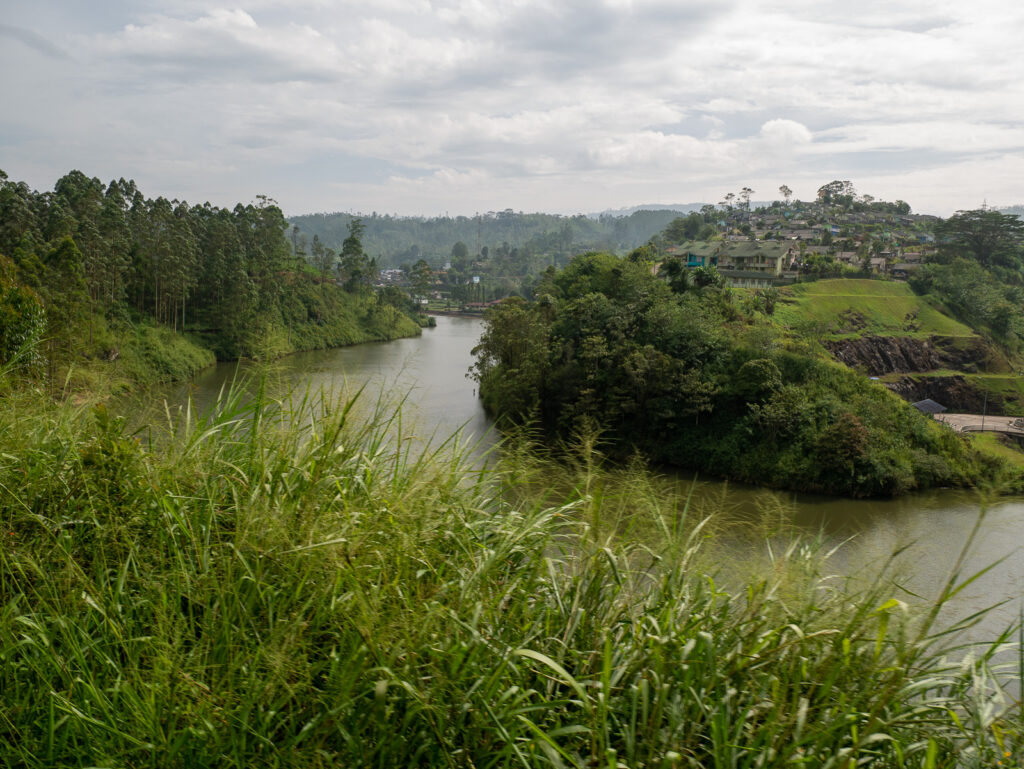
“Gandalf, Gandalf! There’s Rivendell!” (Actually, it’s Talawakelle overlooking the Kotamale Reservoir.)
After passing through Talawakelle Station, we were greeted by the imposing, distinctly not-Sri-Lankan St. Patrick’s Church on a hilltop to the left of the tracks. Beyond that, we were reminded we were in tea country once again as we left town and came upon the large, white rectangular box of the St. Clair Tea Factory closely followed by a view of St. Clair Falls across the valley. All here seems subdued, even the falls, in contrast with the crashing heights and open expanses that we experienced before Nanu Oya.
According to the early plans for the Ella Odyssey, there were eight different locations the train would stop to allow for pictures of waterfalls and spectacular vistas, but we only stopped at the Nine Arches Bridge and some stations here and there. I learned from a friend that the stops had forced unanticipated delays for other trains on the line, so it appeared most of them had been eliminated by the time we made the trip. Instead, the train took its time and meandered unrushed through the most scenic areas.

St. Clair’s Falls across the St. Clair’s tea plantation.
We took advantage of that pace and the general laxness of the rules to sit in a doorway with our feet dangling over the edge. The countryside crawled by at a pleasant pace. The days we’d spent in the high country leading up to this trip had been misty and rainy, and we’d feared the views would be lost in the fog when we finally took the Odyssey. Today, however, was bright and sunny. All up and down the line, people were out and had their laundry spread drying on bushes, toll roofs, and even railway ties strewn alongside the track. Again, we got the feeling of traipsing through people’s backyards, even though they didn’t seem to mind, often waving or breaking into great grins as we passed.

The tender top leaves that become tea are still picked by hand.
We continued like this until we stopped for a duration in Kandy. Before leaving, we finally got booted from the seats we had taken after Nanu Oya, and we moved to our ticketed seats—then got bumped from those! (Double booked? How could that be?) Because Kandy is a terminal station, you go into a dead end and then leave “backward”—pulled by an engine on the other end of the train—for the rest of the journey to Colombo. Not wanting to travel facing where we had been the entire way back (you can usually spin the seats around using a foot pedal, but all these cars were set up with half the seats facing one direction and the other half facing the other), a conductor moved us to open seats on a window in another car so we could continue the rest of the trip facing the direction we were traveling. As usually happens in Sri Lanka, if you’re patient, things find a way to work out.
Sri Lanka’s Cultural Triangle
Because of the island’s location off the eastern cheek of India and its unique offerings, Sri Lanka has been a stop on the silk road since before the time of Buddha. The ancient Greeks called the island Taprobana, and early Arab traders referred to it as Serendip. (Which is, yes, where the word serendipity comes from, more specifically from the ancient tale of “The Three Princes of Serendip.”)
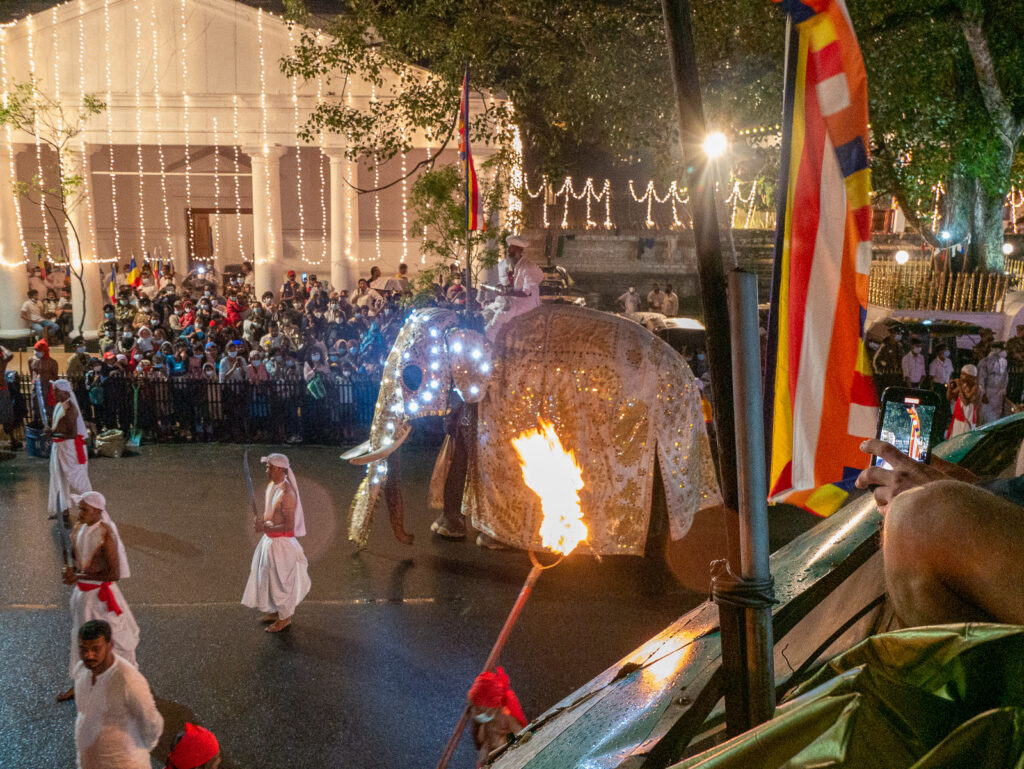
Kandy Esala Perahera.
Kandy is the physical, religious (Buddhist, anyway), and cultural center of the island. The Temple of the Tooth, which houses a relic tooth fragment of the Buddha, and the Esala Perahera that takes place here during the twelve days before the August full moon, make Kandy the heart of Sri Lankan Theravada Buddhism.
Kandy is also the southern tip of the Cultural Triangle (the other two points being the former capitals of Anuradhapura and Polonnaruwa), within which lies the Sri Lankan heartland, which is home to much of its farming and most of its elephant population. Filled with an amazing system of wewas (“reservoirs,” or what locals call “tanks” when speaking English) constructed in the third and fourth centuries, the Cultural Triangle is also filled with the richest concentration of Sri Lankan heritage sites, including monuments, temples, and palaces that were seats of power for more than two thousand years.
Starting with Anuradhapura, the Sinhalese from northern India built several capitals between the time of Buddha and the coming of the Portuguese in 1505. The longest standing was this first in Anuradhapura, which lasted from roughly the second century BCE to 1073.
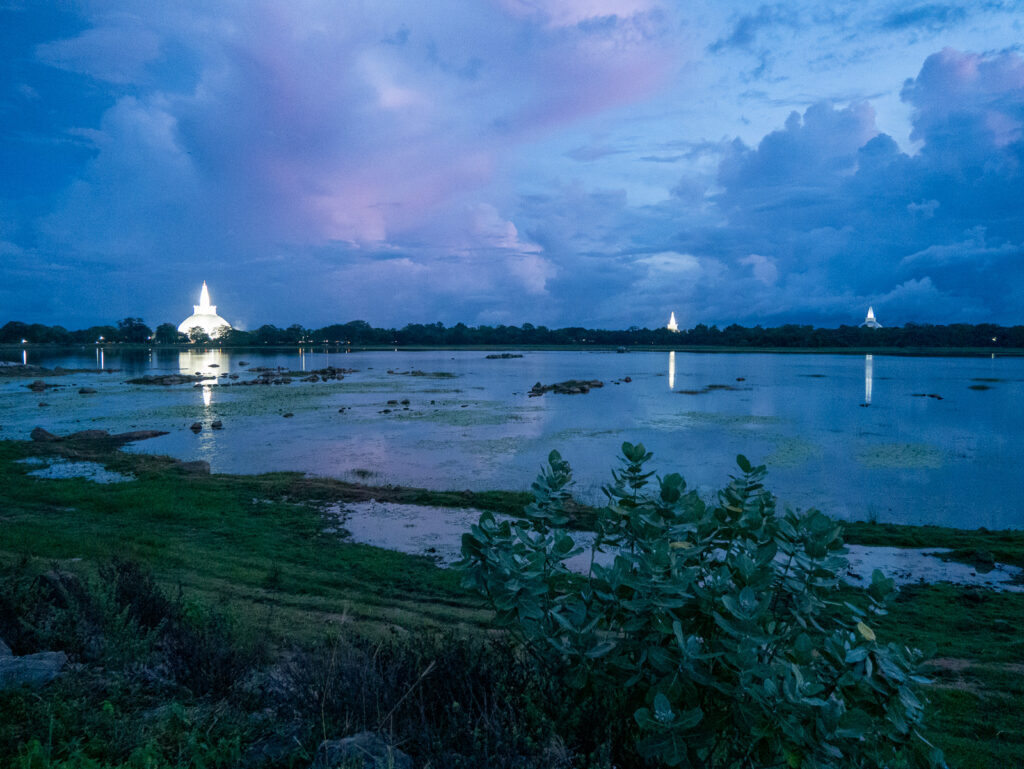
Stupas at dusk in Anuradhapura.
The Anuradhapura period was briefly interrupted when King Kashyapa built the high fortress of Sigiriya and made it the political capital between 477 and 495 CE—this because he feared retribution from his brother, Moggallana, whose throne he usurped after entombing their father, King Dhatusena, alive. (Kashyapa was the older son but judged illegitimate because he was born to a concubine. He definitely had a chip on his shoulder.)
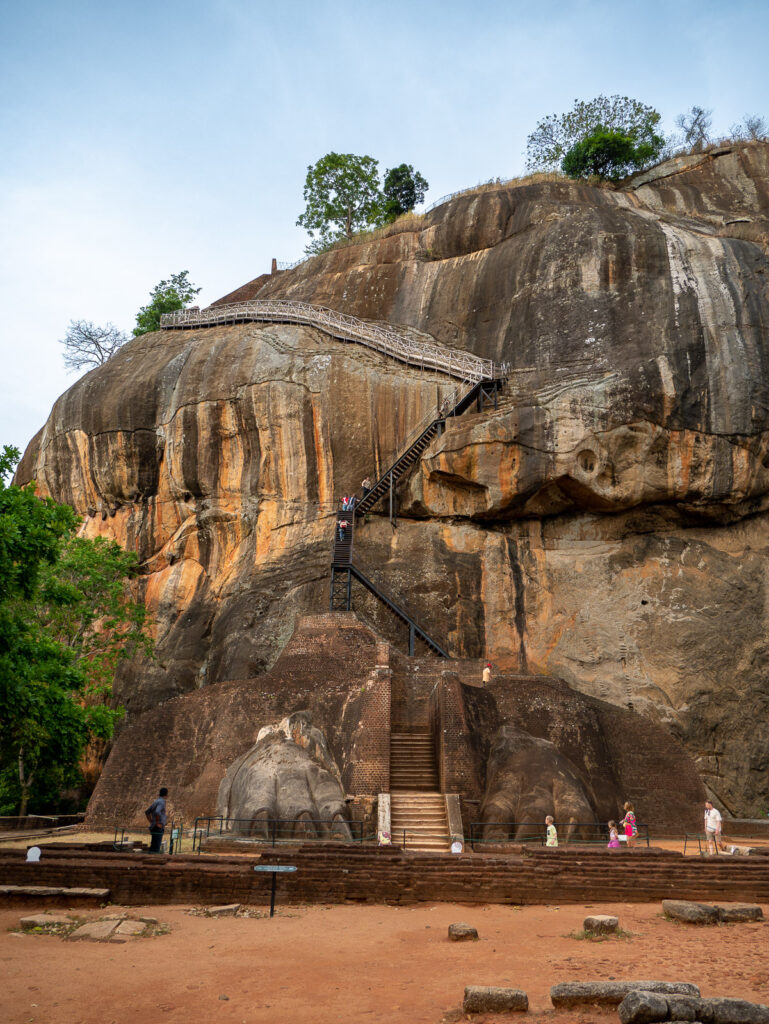
The final ascent, through the lion’s paws, to the top of Sigiriya.
Moggallana fled to South India, built up an army, then turned to retake his throne. Stories of Kashyapa’s demise vary, but the one our guide told us was that Kashyapa’s war elephant got bogged down in a swampland and his delay caused his army to believe he had deserted them. As this rumor spread among the troops, they abandoned the fight, and Moggallana’s army descended on Kashyapa. To avoid capture, or worse, Kashyapa slit his own throat.
Upon becoming king, Moggallana returned the capital to Anuradhapura and gave his upstart brother’s magnificent palace—high upon the perch of Sigiriya rock—to Buddhist priests to use as a monastery. Today Sigiriya is still only partially excavated, but you get a taste for the grandeur it once was, and marvel that it was built in such a short amount of time. (Some suggest aliens were involved, which would explain a lot. In the rainy season during December, many of the pressure-fed fountains still work as water is captured atop the rock and funneled down into the gardens through clay pipes that are still intact.) Though it was the shortest-lived, it is probably the most remarkable historical capital on the island.
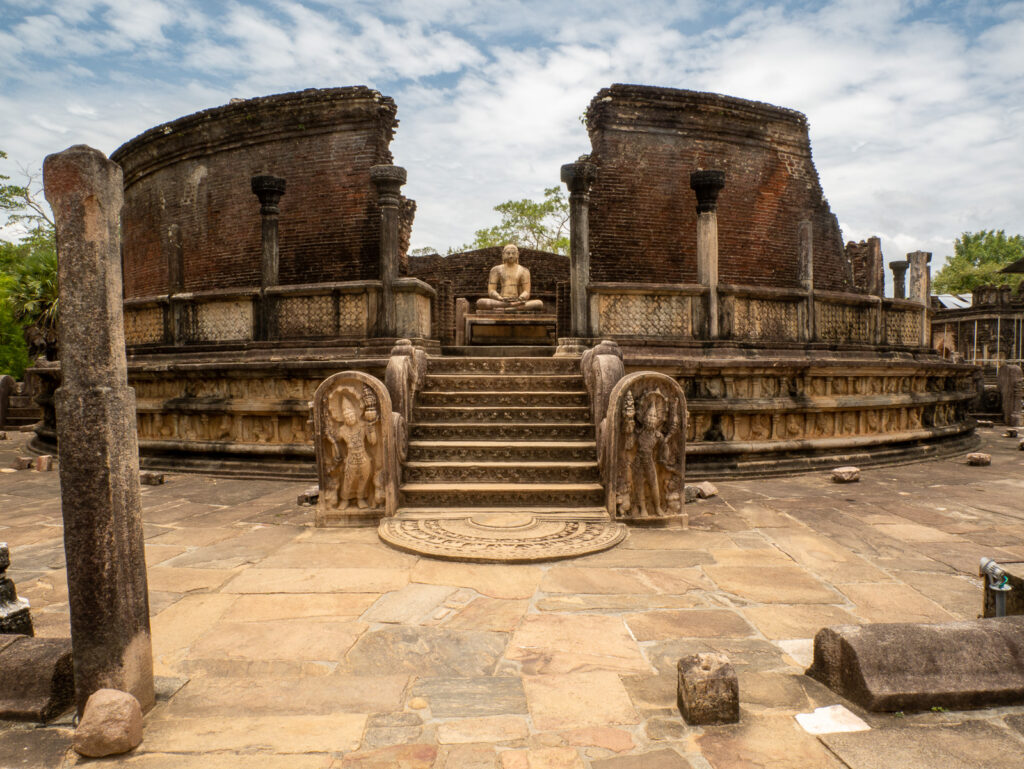
Among the ruins of Polonnaruwa.
During the eleventh century, Polonnaruwa was built as a new capital in the jungles farther east to make it less vulnerable to attacks from India. Polonnaruwa only lasted as a capital until 1232. Then, after a series of other relocations throughout the heartland, Kandy rose to prominence in 1470 and remained the capital of an independent kingdom until the British negotiated its surrender in 1815.
From Kandy, the main line turns west toward Colombo, so you don’t see any of the Cultural Triangle unless you get off the train and travel by roadway. There is a spur of the railroad that goes north from Polgahawela into the Cultural Triangle, but you need a different ticket for that.
The Final Stretch of Track

Adam’s Peak is hard to miss, even from this distance. (Yes, the little bump in the middle there.)
Vistas get spectacular again as the train drops out of Kandy towards Colombo. Distant mountainsides are again veiled in mist, and you feel transported once more into a mythical world where you wouldn’t be surprised if Hanuman appeared out of nowhere, up to some mischief. The railway hugs the cliffsides, passing through occasional tunnels, and spectacular vistas stretch southwest toward Adam’s Peak (Sri Pada), which you can occasionally see in the distance standing solitary and erect over the surrounding mountains and countryside. It’s easy to see why this stretch took so long to build—most of it feels literally etched into stone cliffs.
With the drop in altitude (Kandy is at 1,640 feet) comes a rise in temperature. Rainforests give way to jungle, and tea plantations and vegetable gardens are replaced by rice paddies. We again began to feel the mugginess of humidity we had come to accept as the norm. By the time you reach Rambukkana, everything has flattened out to about sea level again and we were back in the Sri Lanka we knew.
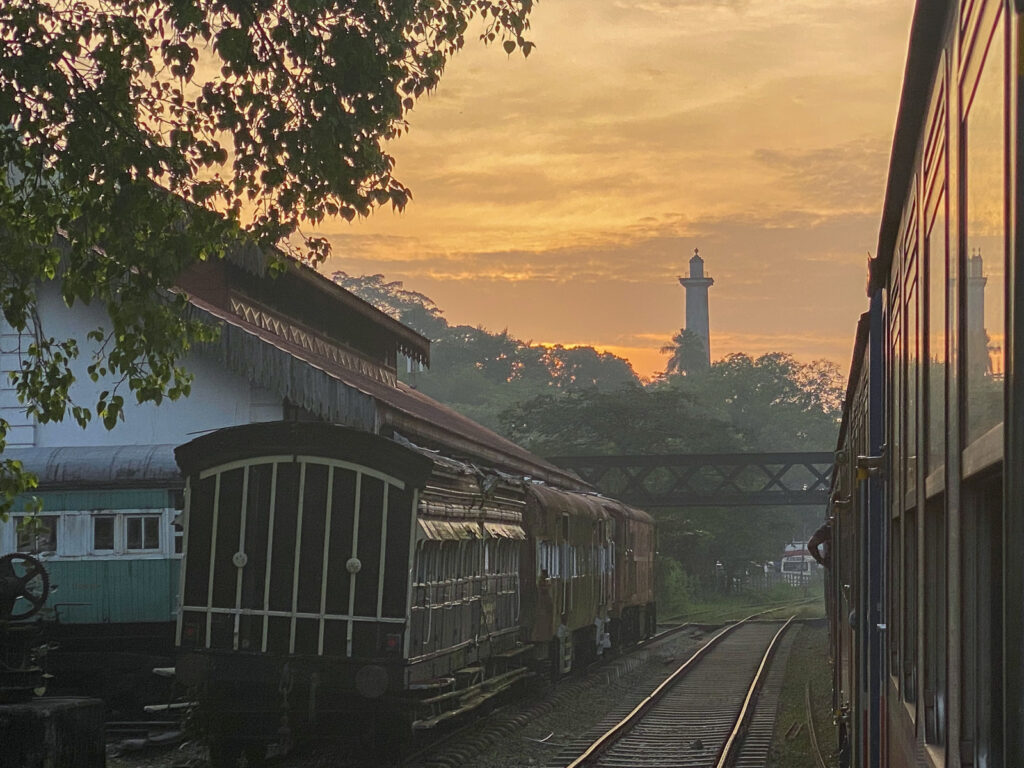
Captain Dawson Tower at sunset.
Just before dusk, we arrived in Kadugannawa for a view of the Captain William Francis Dawson Tower against the sunset from the train station. Dawson was the Commanding Royal Engineer in charge of building the Colombo-Kandy road. That work (before the railroad was even a thought) began in 1820, but Dawson died in 1829, before its completion, from a venomous snake bite. The tower was erected in 1832, funded “By a subscription among his friends & admirers in Ceylon,” according to the tower’s plaque. It is yet another artifact that feels out of place in rural Sri Lanka as it looms above the forest of palms, once again an expression of what author Razeen Sally called “the paradoxical land.” It’s an island with too many adoptive parents, too few of which cared for raising Sri Lanka to competent adulthood.
With the sun down, we hit our top speeds, quickly closing the gap between Kadugannawa and Colombo where we would emerge from the train at 8:32 pm, a little more than an hour beyond the expected arrival time. We were a bit fatigued, but “full” in the way only an overload of scenic wonder can make you feel.
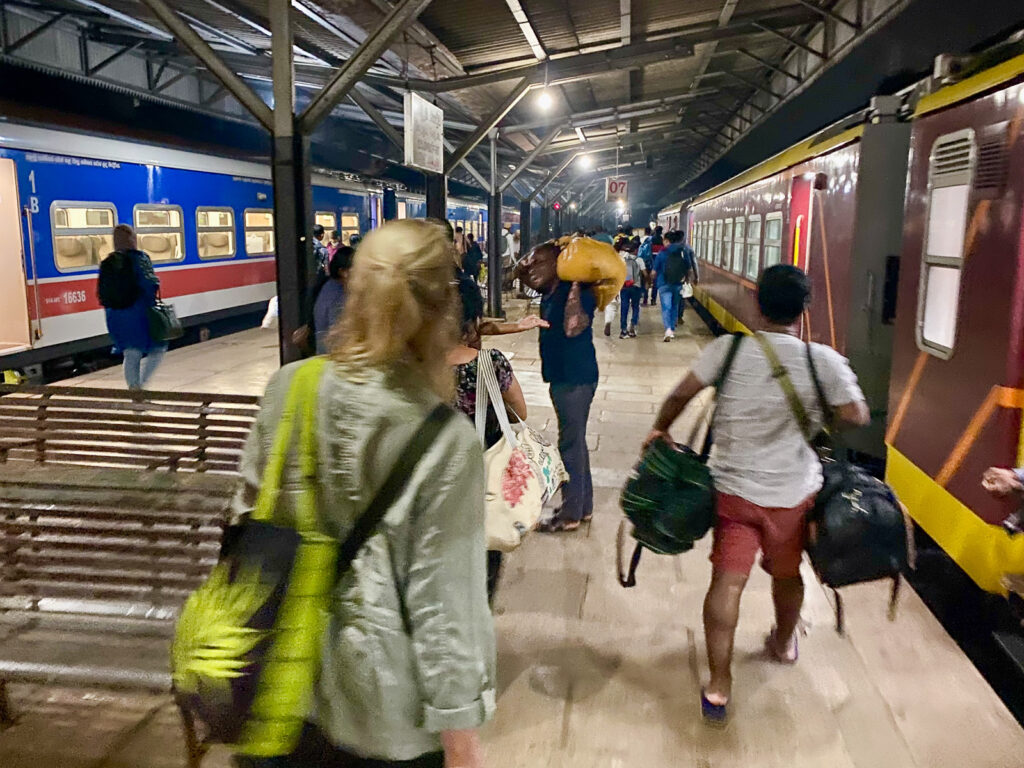
Working our way through Colombo Fort Station to find a tuk-tuk back to our apartment.
So, in the final analysis, is the Odyssey Express really “the most beautiful train ride in the world”?
Until I ride more trains, I would have to say “Yes.” It is also definitely among the top five things I would suggest doing in Sri Lanka—if not my favorite. (Though there is also seeing elephants near Minneriya, and the Perahera, the leopards of Wilpattu, and the incredible and serene eastern beaches. Hmm.) If you were going to be Sri Lankan about it, you could say it is “the most beautiful large-gauge train ride in the world.” Which again, I would have to say is true, at least until I have ridden all the others.
Regardless, I’m so glad we didn’t miss doing this one. If I ever get back to Sri Lanka, I am definitely going to do it again.
If you have a big idea that needs to be turned into a book, feel free to set up a call to get started, or sign up for our free “Twenty-one Days of Writing Inspiration” through the pop-up window on our website: KillianCreative.com.

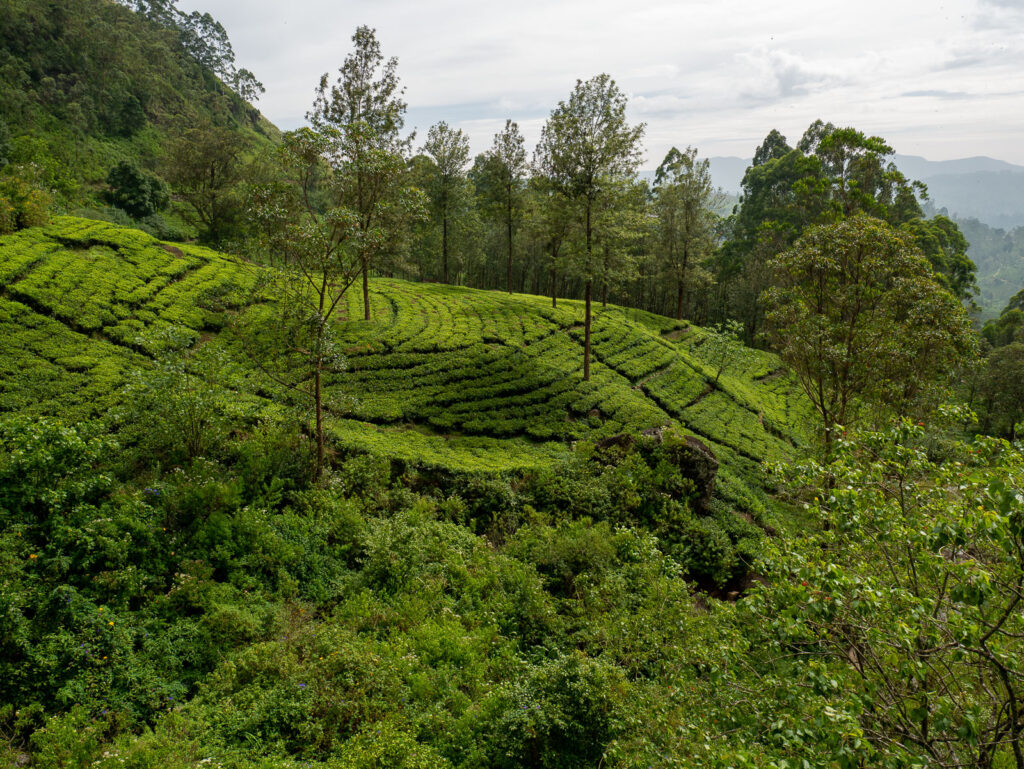
Recent Comments